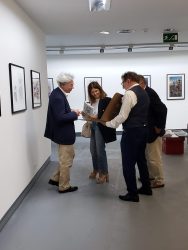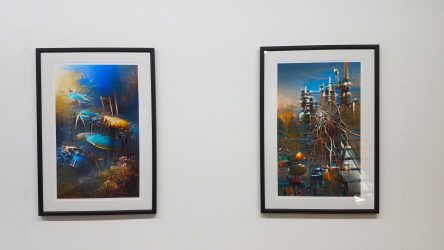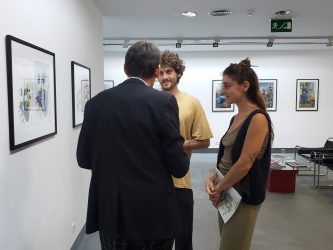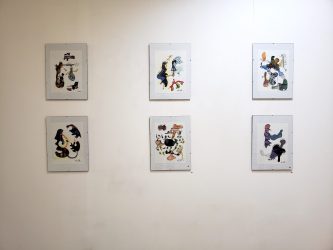Synthetic Evolution
The Synthetic Evolution series uses artificial intelligence algorithms to create and evolve my hand-drawn visual forms, patterns, and images into new experimental works and moving image pieces.

These hand drawn works are related to my robotic generative artworks. In my interactive works I use motors, sensors, machine diagrams, and programming to custom build large-scale interactive robotic installations. As I work with these diagrams, circuit designs and custom machine designs, I have also found an aesthetic that is beautiful. My original drawings have become the training sets for the AI works, and I have conflated machine diagrams with biological forms, and use the machine diagrams to further suggest flow and function.
In the Synthetic Evolution exhibition using artificial intelligence engines, I started by defining a set of rules and parameters based on my hand-drawn works as training DATA sets. These are then conflated with very large language models, allowing an AI algorithm to generate new visual works from the original drawings.
The rules are derived from my original compositions, and because the drawings are abstract and also suggestive, the works that are rendered by the AI are also more abstract, experimental and slightly suggestive. The algorithms create a large number of initial variations based on these rules, and then as artist I select the most interesting or appealing examples, to evolve further.
This process is repeated hundreds of times, and once I find a work that I feel reflects the best relationship between the original hand-drawn work, and the AI generative work with words used to pull from WWW data bases, I go back into the digital works and add color and further manipulate form, before arriving at the final work of art.
Once these are complete I bring them into a video program and show the original morphing into the AI generative work and us AI generative sound to further add to the experience of watching this AI evolution in action.
Synthetic evolution using AI in visual art is an exciting and rapidly growing field, and I am exploring its potential to create new forms of expression that may challenge traditional notions of creativity and authorship. By combining the power of artificial intelligence with my vision and intuition, synthetic evolution has the potential to lead to new forms of art that blur the boundaries between human and machine-generated creativity.

Artificial intelligence tools with machine learning are transforming the arts and sciences. I am most excited by AlphaFold’s ability to accurately predict 3D models of protein structures, which also has the potential to transform the field of biology. While DNA is a slow and effective means of the evolution of all species, AI technology has become an accelerant impacting how all species, including our own will further evolve.
AI tools have also become readily available for art remixing, and culture is on fire, metaphorically and literally.

So how do artists support the coming AI, neural network, and big-data art boom? We learn the tools and the technology and engage in the process of remixing. Suppose the artist cares not for the tools we have.

We create new AI algorithms, processes, and techniques in that case. I feel strongly that we must misuse the tools, often designed for commercial ends, while expanding our imaginations and the dialogue surrounding AI art aesthetics.
We may not personally have determined what technologies or tools we use or engage with, though as artists, ultimately, we are forming them, and they are creating, developing, enveloping, and forming us.
Synthetic Evolution’s exhibition deconstructs and reworks existing hand-drawn works as training sets for the AI that takes and further evolves and mutates these images, using additional vital words inspired by these drawings to steer and elicit new algorithmically generative works using this data.


The images were selected from the Sacs, Membranes, Motors, and Vesicles Series and The Immaculate Organicism series. These images are fed into artificial intelligence and vision systems using learning algorithms and generative adversarial networks. (GANS)
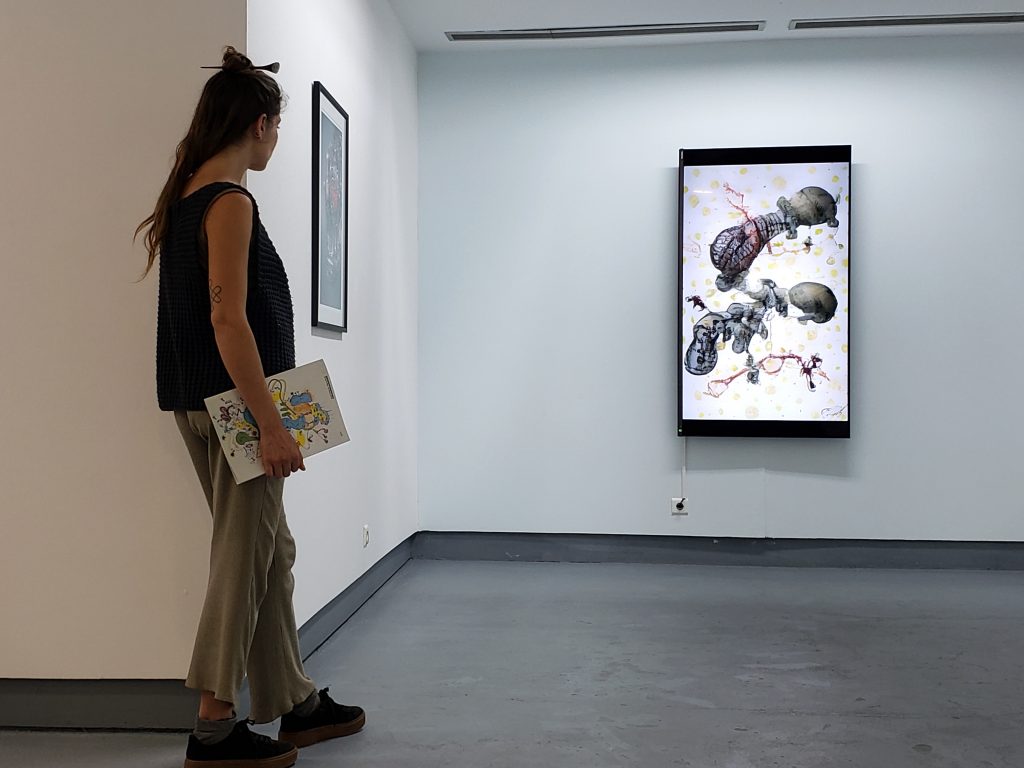
The drawings of microbial worlds, machine diagrams, and biomorphic remixes combined with the AI systems’ learning algorithms and keywords created dynamic color, composition, and form and realized an evolved human-machine aesthetic.

As artificial intelligence (AI) is now more fully influencing visual culture, we are witnessing the emergence of authentic synthetic aesthetics. Big data, vision systems, and image analysis, unified with artificial intelligence, can now replicate artistic styles well enough to fool experts in the field, forcing us to question the nature of creativity.

Part of the exhibition also consists of images composed by artificial intelligence using words to pull from large databases of images on the world wide web.

They are brought into the system, and the AI algorithms work to resolve the visual collages that result from these many words or phrases.
Hundreds of images are rendered before one or two are selected. After they are generated, I go back into the renders and add color, line, and form.
As biological species have emerged, so too have algorithmic species arisen. The availability of knowledge at the fingertips of most has changed the nature of how we imagine and create, and the individual now joins an emergent cognition of web knowledge guided by human notions of aesthetics.

With machine learning, the computer is at the edge of showing evolutionary survival instinct and emergent self-aware software agents.
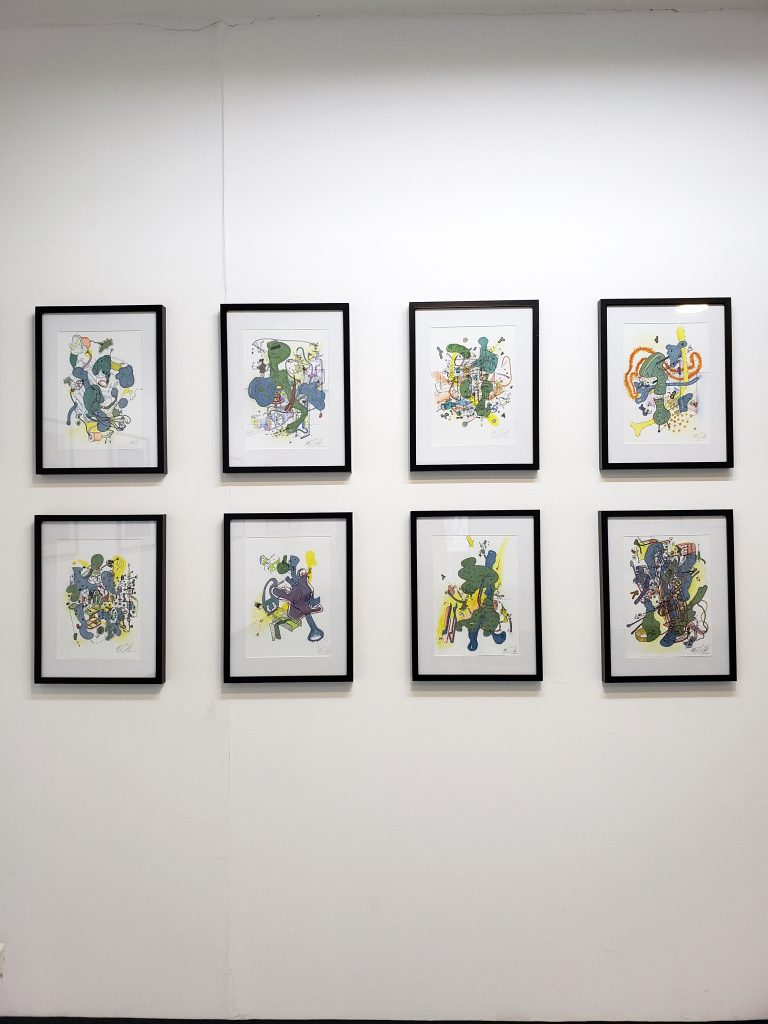
Epistemology has always been about lenses, and when lenses were analog and made of glass, they changed our worldviews profoundly. Our lenses are still made of glass, though silicon and algorithms are supplanting optical lenses, and databases and algorithms have given us new ways of understanding our world.

Data-based algorithmic ways of knowing are becoming predominant.

Digital visualization and fabrication technologies are increasingly supplanting the hand of the artist, and the computer has become an ideational amplifier. These technologies, in association with biological procedures, such as CRISPR Cas9, will mean a semi-living constructed species can and will appear.
As a species, we are more fully intimate with the machine in this age of computer-based art forms.

We witness nature through a phone and smart TV screen, and nature has been replicated as images and videos to be experienced inside screens.
Human data is seeded, collected, and sold, and the human-machine symbionts have now fully emerged, further impacting artmaking and, ultimately, the evolution of visual culture.

This exhibition explores the junctions and disjunctions between natural and synthetic ways of evolving artworks, asking what the machine may learn from us and what we may learn from the artificial perceptions, replications, and manipulations that the algorithms advance as computer cognition emerges.

An additional part of this exhibition is two edited video reels with artificially intelligent composed sound, showing you the computer’s variations in trying to learn and resolve the final images as they struggle to match the artists’ forms, lines, and colors.


Exhibitions
UGO CARA MUSEUM OF MODERN ART Muggia, Italy, Sept, 21 2023
ROBOTICS; ARTE E ROBOTICA invites the Italian premiere of the Synthetic Evolution prints and videos new renditions and world wide premiere of the Anthropogenic Slot Machine and curated by Maria Campetelli.
FORT HAYES GALLERY Columbus, Ohio, US – March 13-April 22 2023
Flow: visual interpretations on the theme of water invites Synthetic Evolution AI prints and video, curated by Teresa Weidenbusch
UNIVERSITY OF YORK York, England, 14-16 December 2022
Artist residency at the Leverhulme Centre for Anthropocene Biodiversity, showing Synthetic Evolution works curated and invited by Dr. Sarah Bezan and Dr. Peter Sands.
SYRACUSE UNIVERSITY Syracuse, New York, Nov 2022
Bio-Art Mixer presentation of my work and exhibition of three works and videos in the faculty gallery, invited by Professor Boryanna Rossa
THE FESTIVAL OF UNCONVENTIONAL COMPUTING, PROTO-COGNITION, AND SOUND Bristol, UK, Sept-Oct 2022
Artworks at the edge of arts, science, philosophy, and engineering invite four works from Synthetic Evolution and videos curated by Irina Pretrova and organized by director Professor Adam Adamanzky.
FIG BILBAO Bilbao, Spain, November 2022
Centro Portuguese de Serigraphia exhibits the Synthetic Evolution works + the premiere of four new AI works invited by Joao Prates.
ANTONIO PRATES GALLERY Lisbon, Portugal, June 2022-September 15, 2022
A one-person exhibition of Synthetic Evolution inspired by the intertwining of human and machine interactions. Invited by Antonio Prates in collaboration with Centro Portuguese de Serigraphia and Joao Prates.




